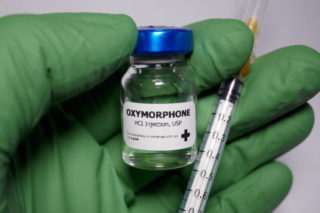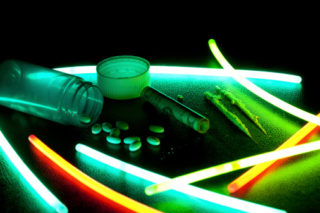Addiction to Opana
According to the American Addiction Centers, opioid drugs are most likely to be abused in the United States. In a 2014 report, the National Survey on Drug and Health (NSDUH) reported that nearly 4.3 million Americans were abusing Opana and other prescription drugs.
Opioids like Opana are highly addictive because they can reduce pain and induce a desirable sense of relaxation and euphoria. Regular use of the drug, even with a doctor’s prescription, often results in dependency and addiction.
In 2017, the Food and Drugs Administrations (FDA) asked Endo, the manufacturer of Opana, to withdraw it from the market because of what CNN called “the likelihood of being abused.” That year, there were nearly 200 million opioid prescriptions, two million opioid abusers and 48,000 opioid overdoses in the U.S. alone.
Physical Symptoms of Opana Addiction
When addicted to Opana, individuals find it challenging to control usage of the drug, meaning they cannot regulate the dosage, frequency and length of time of use. Even though they try, they cannot stop using Opana. According to WebMD, most Opana addicts exhibit symptoms similar to those of alcoholism, which include:
- Slurred speech.
- Staggering or falling.
- Poor choices.
- Risky sexual behavior.
- Slowed reflexes.
- Difficulty thinking clearly.
- Drowsiness.
- Mood swings.
- Poor eating habits.
- Impaired motor coordination.
- Short-term memory lapse.
Psychological and Social Symptoms of Opana Addiction
Once a person becomes addicted to Opana, they experience effects beyond the physical symptoms discussed above. One of the likely effects of Opana addiction is retreating and withdrawal from family and friends. By seeking to remain secretive, they stop joining formerly important activities, reducing their social circles, and spend most of the time looking, using, and recovering from Opana. Users end up with severe social and psychological symptoms, which include:
- A compulsion to get and use more and more doses of Opana.
- Issues in one’s relationships and performance at work.
- Loss of confidence in personal values and integrity as the addiction escalates.
- Struggling with irritability, anxiety and general nervousness.
- Exposure to the risk of legal trouble, injury and accidents.
- Engaging in questionable or illegal activities to finance the Opana addiction.
Opana Withdrawal Symptoms
Opana addiction often results in the need for higher doses to get a high as well as physical dependence. Without the drug, it becomes impossible for addicts to function normally. Whenever they stay for at least 14 hours before taking the drug, Opana addicts suffer from opioid withdrawal symptoms.
Some symptoms of Opana addiction:
- Anxiety
- Vomiting
- Depression
- Nausea
- Irritability
- Tremors
- Restlessness
- High Blood Pressure
- Increased Heart Rate
- Diarrhea
- Runny Nose
- Joint And Muscle Pain
- Agitation
- Fever
- Chills
- Agitation
- Sweating
- Dilated Pupils
- Insomnia
- Yawning
- Tearing
How Is Opana Abused?
Opana is available as an octagon-shaped tablet in either an immediate-release or extended-release (Opana ER) format. Users can swallow, chew or crush as well as inject, smoke or snort the tablet. It is unnecessary to get a doctor’s prescription to abuse it since, on the street, oxymorphone goes by various names:
- Mrs. O
- Pink Lady
- New Blues
- Stop Signs
- Blue Heaven
- The O Bomb
- Octagons
- Organa IR
- Pink Heaven
- OM
- Oranges
The abuse of Opana can slow down key CNS functions like anxiety levels, breathing rate, blood pressure, heart rate and others related to the stress response. You don’t need to use it in large doses.
According to the FDA, the drug can cause tolerance, which is the need for an increased dosage to get pain relief, even when it is taken in doctor-recommended dosage. The risk of Opana dependency increases if you take it as a recreational drug to get high.
Opana addiction is so severe that the abuser cannot stop using it simply by cutting its use. Doing so induces opioid withdrawal syndrome characterized by severe symptoms. The best method to stop using Opana is medical detox accompanied by medication and psychological counseling.
The Extent of Opana Addiction in the U.S.
According to the Drug Enforcement Administration (DEA), addiction to Opana is much like alcoholism, affecting young white males more than any other demographic. In 2014, the NSDUH reported that the individuals who mostly abuse opioid drugs are in the 18 to 25 age demographics.
Before the OcyContin (oxycodone) reformulation of 2010, Opana abuse was not an issue of concern in the U.S. because abusers preferred oxycodone. According to Reuters, individuals had to switch to Opana after the reformulation since it is one of the easiest opioids to alter into an easily abused form.
In a 2013 petition to the FDA, Endo Pharmaceuticals sought to restrict the sale of generic oxymorphone and make Opana more difficult to abuse. The FDA declined to put safeguards on generic forms of Opana, making it possible for abusers to alter it for snorting or injection.
According to the DEA, opioid addiction caused 20,000 deaths in the U.S. in 2016, with drugs such as Opana accounting for four out of seven top prescription drugs distributed at the retail level nationally. In 2017, the DEA report indicated more than 14 million retail purchases of opioids in the U.S.
Opana alters brain chemistry, changing how the body processes pain and feels pleasure. Its continued use leads to tolerance followed by addiction. Drug addiction has both physical and psychological symptoms, with addicts likely to experience drug cravings, moodiness, restlessness and difficulty sleeping without the drug. Abusers may also experience substance use disorder that feels like a severe case of the flu.
The unrestricted presence of opioid drugs in the system triggers an imbalance of brain chemicals that react with opioid receptors, inducing excessive neurotransmitters responsible for mood regulation, pleasure, motivation and decision-making abilities.
The sudden cessation of Opana use after forming dependence causes the brain to work overtime to restore balance, leading to undesirable side effects. For many users, there is no option but to continue taking the drug in order to alleviate the side effects of withdrawal, resulting in compulsive drug abuse and addiction.
Signs of Opana Overdose
Despite being a prescription drug, Opana is prone to overdose both among its legal and illegal users. According to the CDC, opioid overdose causes approximately 40 deaths daily in the U.S., with at least a half of the deaths involving Opana.
According to Reuters, Opana is more potent per milligram than oxycodone (OxyContin). Individuals who take the drug for recreational purposes may increase the dosage gradually until they start taking too much of it. That may cause an overdose, which occurs when Opana overwhelms the system and proves hard to metabolize. As a result, vital systems like cardiovascular functions and respiration shut down.
According to the DEA, the following are the symptoms of oxymorphone overdose:
- Chest pain
- Dizziness
- Blue tinge to nails, lips, and skin
- Limp muscles
- Significant drowsiness
- Clammy or cold skin
- Irregular blood pressure, heart rate or pulse
- Loss of consciousness and coma
- Slow breathing or trouble breathing
- Numbness in hands, feet, and other extremities
Usually, an overdose occurs when users alter Opana ER, crushing it to inject, smoke or snort it. That circumvents its extended-release format, introducing the entire dosage into the bloodstream at once. The result is any of the above symptoms of Opana overdose or, at the very worst, death.
How to Treat Opana Addiction
The problematic nature of withdrawal symptoms makes it difficult to stop using Opana. Consequently, anyone attempting to stop using the drug without help is likely to relapse to end the withdrawal symptoms. While getting through the first day is possible, withdrawal symptoms usually worsen after the first or second day.
According to Medline Plus, the best way to treat Opana addiction is through medical detox. The addicted individual joins a safe, supportive institution where a medical team takes them through detox.
Usually, the person switches from Opana to Buprenorphine/Naltrexone, buprenorphine or other medication to make it easier to go through the withdrawal phase. With time, the individual is weaned off the replacement medication until they are completely free from opioids.
However, becoming sober or getting over withdrawal symptoms don’t indicate total recovery from Opana. The staff at a treatment center always seek to address the psychological and social issues that led to the addiction to prevent a relapse. As a result, the recovering addict must learn to cope with the issues, such as physical or emotional pain, that led to Opana addiction.
The individualized treatment makes it possible to help each individual successfully recover from Opana addiction. That’s because each individual has a unique path to recovery, necessitating the need to consider their needs when designing a treatment regimen.
Some factors to consider may include physical health, mental health, history of drug use, resolve to recover and the type of family or support system. Freedom from Opana abuse is possible with individualized care and a holistic, strategic approach to recovery. Even though highly addictive, it is possible to get Opana out of the system by joining a reputable substance abuse recovery center.
If you or a loved one is addicted to Opana, contact Windward Way Recovery to get the help you need to stop using the drug today. Our experts are standing by to assist you. Call our hotline (855) 491-7694 now!
Related Pages






